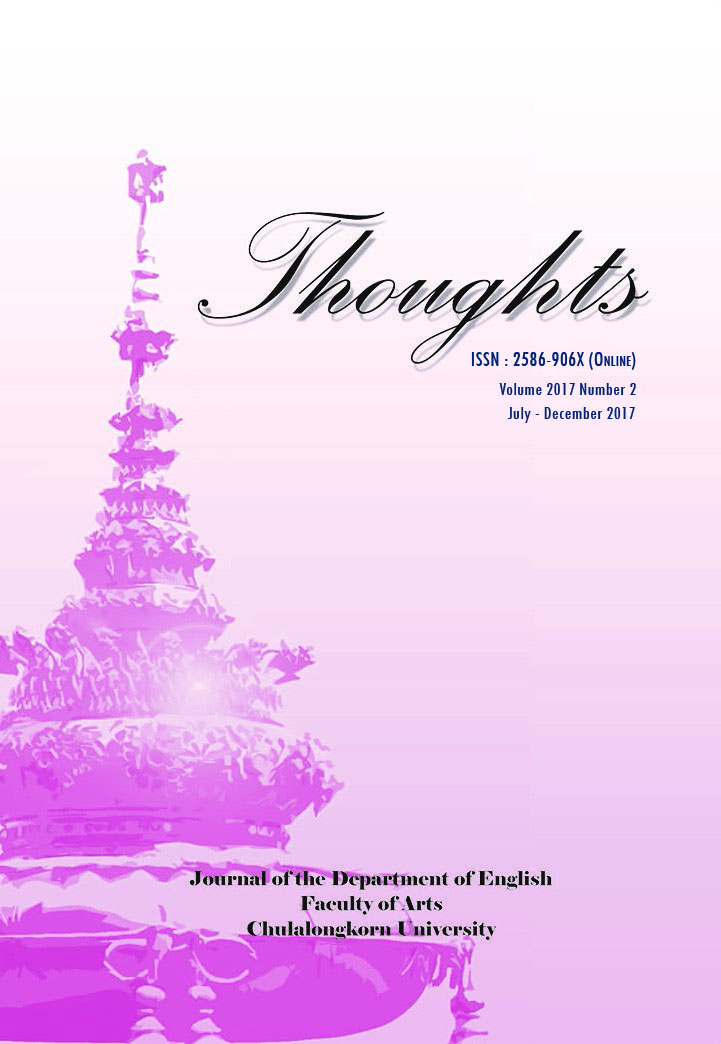Really Good or Real Good? A Corpus-Based Approach to the Grammaticalization and Delexicalization of Real
Main Article Content
Abstract
This study deals with the intensifying/emphasizing use of real, as in real good, the real question, which highlights the qualities indicated by the following adjective or nominal description. More specifically, it investigates the evolution toward Intensifier/Emphasizer by tracing real’s micro-diachronic progress along the two structures ‘real + adjective’ and ‘real + noun’. The observations of prominent collocations show an ongoing grammatical change of real, e.g. real predominantly modifying a nominal good in 1820s but mainly functioning Intensifier in the same string real good after 1930s. Still, this transition seems limited to a certain set of collocates. Real in collocation with nouns such as estate, world, life never functions as Emphasizer.
Article Details
Copyright by the Faculty of Arts, Chulalongkorn University.
Photocopying is allowed for internal, non-commercial use only. Photocopying for other uses or for purposes other than indicated must be permitted in writing from the Faculty of Arts, Chulalongkorn University.
All views or conclusion are those of the authors of the articles and not necessarily those of the publisher or the editorial staff.References
Adamson, S. (2000). A lovely little example. Word order options and category shift in the premodifying string. In Olga Fischer, Anette Rosenbach & Dieter Stein (Eds.), Pathways of Change: Grammaticalization in English (pp. 39-66). Amsterdam & Philadelphia: John Benjamins.
Blanco-Suárez, Z. (2014). Oh he is olde dogge at expounding deade sure at a Catechisme: Some considerations on the history of the intensifying adverb dead in English. Acta Linguistica Hafniensia, 46(1), 117-36. http://www.tandfonline.com.libproxy.ucl.ac.uk/doi/abs/10.1080/03740463.2014.956399#.
Bolinger, D. (1972). Degree Words. Mouton: The Hague.
Biber, D., Johansson, S., Leech, G., Conrad, S., & Finegan, E. (1999). Longman Grammar of Spoken and Written English. Harlow: Longman.
Buckingham,J. T., Bunkingham, E., Howe, S. G., Sargent, J. O., & Benjamin, P. (Eds.). (1883). The Temperance Pledge. The New-England Magazine 5, 137-140. Boston: J.T. Buckingham.
Croft, W., & Cruse, A. (2004). Cognitive Linguistics. Cambridge: Cambridge University Press.
Ghesquière, L. (2014). The Directionality of (Inter)subjectification in the English Noun Phrase Pathways of Change. Berlin & Boston: Walter de Gruyter.
Huddleston, R. D., & Pullum, G. K. (2002). The Cambridge Grammar of English Language. Cambridge: Cambridge University Press.
Lorenz, G. R. (1999). Adjective Intensification—Learners versus Native Speakers: A Corpus Study of Argumentative Writing. Amsterdam & Atlanta, GA: Rodopi.
Lorenz, G. R. (2002). Really Worthwhile or Not Really Significant? A Corpus-based Approach to the Delexicalization and Grammaticalization of Intensifiers in Modern English. In Ilse Wischer & Gabriele Diewald (ed.), New Reflections on Grammaticalization, 143-61. Amsterdam & Philadelphia: John. Benjamins.
Nevalainen, T., & Rissanen, M. (2002). Fairly pretty or pretty fair? On the development and grammaticalization of English downtoners. Language Sciences, 24(3), 359-80.
Oxford English Dictionary Online. (n.d.). Retrieved from http://www.oed.com.libproxy.ucl.ac.uk/
Partington, A. (1993). Corpus Evidence of Language Change: The Case of Intensifiers. In Mona Baker, Gill Francis & Elena Tognini-Bonelli (ed.), Text and Technology: in Honour of John Sinclair, 177-92. Amsterdam & Philadelphia: John Benjamins.
Quirk, R., Greenbaum, S., Leech, G. N., & Svartvik, J. (1972). A Grammar of Contemporary English. London: Longman.
Sinclair, J. (1990). Collins COBUILD English Grammar. London: Collins.
Traugott, E., & Dahser, R. (2002). Regularity in Semantic Change. Cambridge: Cambridge University Press.
Vandewinkel, S., & Davidse, K. (2008). The interlocking paths of development to emphasizer adjective pure. Journal of Historical Pragmatics, 9(2), 255-87.
Yaguchi, M., Iyeiri, Y., & Baba, Y. (2010). Speech style and gender distinctions in the use of very and real/really: An analysis of the Corpus of Spoken Professional American English. Journal of Pragmatics, 42(3), 585-97.
